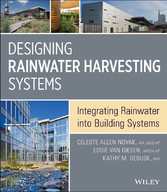
Designing Rainwater Harvesting Systems - Integrating Rainwater into Building Systems
von: Celeste Allen Novak, Eddie Van Giesen, Kathy M. DeBusk
Wiley, 2014
ISBN: 9781118417867
Sprache: Englisch
312 Seiten, Download: 24974 KB
Format: EPUB, auch als Online-Lesen
Mehr zum Inhalt

Designing Rainwater Harvesting Systems - Integrating Rainwater into Building Systems
Chapter 1
The Importance of Rainwater Harvesting
Rain water harvesting and conservation aims at optimum utilization of the natural resource that is Rain Water, which is the first form of water that we know in the hydrological cycle and hence is a primary source of water for us. The Rivers, Lakes, and Ground Water are the secondary sources of water. In present times, in absence of Rain Water harvesting and conservation, we depend entirely on such secondary sources of water. In the process it is forgotten that rain is the ultimate source that feeds to these secondary sources. The value of this important primary source of water must not be lost. Rain water harvesting and conservation means to understand the value of rain and to make optimum use of Rain Water at the place where it falls.
—India: Rain Water Harvesting and Conservation Manual1
Figure 1.1 Queens Botanical Garden Visitor and Administration Center is an example of integrated rainwater harvesting system design.
WATER CAPITAL
Water is the only commodity on Earth for which there is no economic substitute. Seventy-five percent of the Earth’s surface is covered in water, yet only 2.5 percent of it is suitable for human consumption. Of that 2.5 percent, most is locked in polar ice caps or hidden beyond the reach of commercial technologies.2 All life forms on the planet depend on water to survive. Simply stated, water is the basis for all life on Earth.
The more technologically advanced humans become, the more water is consumed on a per capita basis. Electricity use within a typical home requires 250 gallons (almost 1,000 L) of water per day per person; the manufacturing processes of computer chips, televisions, and cell phones require water, and the production of a half-gallon (roughly 2L) bottle of soda can take over 1.3 gallons (5 L) of pure water.3 Even the production of food requires tremendous amounts of water, as producing 1 pound (0.5 kg) of chicken and 1 pound (0.5 kg) of beef requires over 1,600 gallons (6,000 L) of water!4 Historically, an abundance of water, as well as water scarcity, has affected both the growth and decline of every civilization. History teaches that finite water resources need to be managed with the utmost care.
Figure 1.2 EARTH A Graphic Look at the state of the world5
(Source: Igor A. Shiklomanov, State Hydrological Institute (SHI, St. Petersburg) and United Nations Educational, Scientific and Cultural Organisation (UNESCO, Paris), 1999. Image courtesy of UNEP.)
As profound as our dependence on water is, there is an equally profound lack of knowledge concerning where water comes from and how it is best and most efficiently used as a public and private resource. According to the Environmental Protection Agency (EPA), the following statistics underscore the challenges faced by architects, engineers, and public policy makers as they face looming freshwater shortages:
- The average American directly uses 80 to 100 gallons of water each day, but supporting the average American lifestyle requires over 1,400 gallons of water each day.
- Agriculture is the largest consumer of freshwater: worldwide, about 70 percent of all withdrawals go to irrigated agriculture.
- Only 1 percent of the world’s freshwater is accessible to humans.
- Forty percent of America’s rivers and 46 percent of its lakes are too polluted to support fishing, swimming, or aquatic life.
- Power plants in the United States use 136 billion gallons of water per day, more than three times the water used for residential, commercial, and all other industrial purposes.6
In addition, scientists and researchers are describing a “peak water” crisis for water use throughout the world. As a response to these issues, professionals are developing new strategies to conserve and effectively use water resources.
Peak Water
The planet is getting thirstier as a growing worldwide population is using fresh water resources. Dr. Peter Gleick, president of the Pacific Institute, has coined “peak water” as a description for the world’s water crisis. This concept describes the lack of sustainably managed water throughout the world, just as “peak oil” refers to the lack of oil reserves globally. According to Dr. Gleick, there are three major definitions for peak water. These are:
- Peak Renewable Water: The limit reached when humans extract the entire renewable flow of a river or stream for use.
- Peak Non-Renewable Water: Groundwater aquifers that are pumped out faster than nature recharges them—exactly like the concept of “peak oil.” Over time, groundwater becomes depleted, more expensive to tap, or effectively exhausted.
- Peak Ecological Water: The point where any additional human uses cause more harm (economic, ecological, or social) than benefit. For many watersheds around the world, we are reaching, or exceeding, the point of “peak ecological water.”7
The design challenge is to reverse the direction of peak water so that it is not a linear loss of water, but a regenerating system that allows humans to participate in the continuation of the hydrologic system.
One response to the water supply challenges is the re-creation of one of the world’s oldest water supply systems: rainwater collection. Rainwater collection, or rainwater harvesting, involves the capture of water from roofs and/or impervious/pervious surfaces. The roofs of buildings, schools, offices, large data distribution centers, and agricultural buildings can serve as the contributing drainage area for a given system. Once captured within the rainwater harvesting system, the quality of the runoff water may be improved via physical and biological processes including filtration, disinfection, and other treatment strategies. New approaches in plumbing design are using site-collected rainwater/stormwater to provide all or part of a building’s and its site-related water needs. This results in a reduction of stormwater runoff volumes leaving a site, while at the same time providing a new source of water to reduce the burden on potable water supplies.
Figure 1.3 At the Queens Botanical Garden, rainwater is a valuable resource.
(James Wasley/Atelier Dreiseitl)
Water conservation and stormwater management are two of the most effective sustainable design practices available to architects and engineers. Rainwater collection conforms to the goals and objectives of low-impact development, which aims to mimic the predevelopment site hydrology by using site design techniques that store, infiltrate, evaporate, and detain runoff.8 Reducing the runoff from storm events via rainwater harvesting strategies provides benefits to property owners, including lower municipal fees and larger developable site area, and contributes to the big-picture goal of reducing the impact of urbanization on receiving water bodies.
Rainwater collection is becoming one of the many tools used by sustainable design professionals. Sustainable building rating methods and performance guidelines are influencing the development of rainwater harvesting systems. Projects throughout the world are demonstrating that rainwater collection systems can solve some of our water-related problems. Rainwater systems are meeting the challenges of water conservation while demonstrating the effectiveness of alternative nontraditional water supplies. There are numerous benefits to this approach for the conservation of the world’s most valuable natural resource.
Low Impact Development
Until the 1960s, the philosophy of stormwater management was to dispose of the water as quickly as possible from urban areas to the nearest receiving water.9 Extensive underground piping networks were used to convey runoff from parking lots, roadways, and buildings and discharge it into the closest stream or river. As the negative impacts of discharging stormwater runoff and wastewater into surface waters became apparent, the focus shifted to encompass water quality concerns as well, initiating what is now considered traditional stormwater management.10 The major components of a traditional stormwater system are concrete curbs and gutters, drop inlets (catch basins), underground pipe networks, and detention/retention basins. The majority of modern developments, both residential and commercial, utilize curb and gutters to convey stormwater runoff from impervious surfaces (such as parking lots and roadways) to drop inlets, which are connected to extensive networks of underground pipes that carry the water to large detention or retention basins.
The use of retention and detention basins addresses some water quality and quantity concerns; however, there are detriments associated with their implementation. While retention ponds can reduce peak flows to some extent, recent research has shown that the outflow is often released at rates exceeding that, which can be absorbed by receiving streams, resulting in erosion of the streambed and banks.11 Furthermore, basins are designed to release outflow longer than the duration of the storm event, thereby causing a prolonged state of erosion within the stream.12 Detention and retention basins can also increase the temperature of captured stormwater due to exposure to...









